A common issue that many dog owners struggle with is caring for a dog that eats things she shouldn’t.
Whenever the dreaded question is asked: “What do you have?!” the dog in question knows the jig is up!
Depending on the size of the forbidden item, a speedy game of chase may ensue, or if the thing is small enough, a quick gulp may bring things to a rapid and worrying conclusion.
Below, we will explain why your pooch may want to eat some of those weird and nasty things and share some training and management solutions to help you get her naughty nomming situation under control!
How to Stop a Dog from Eating Everything: Key Takeaways
- Destructive chewing is a relatively common canine problem, but some dogs seem to eat everything that isn’t nailed down. This is doubly troubling, as it means your pooch is not only ruining your stuff but also putting herself in danger.
- There are two primary types of solutions to this issue: management and training. Management solutions seek to simply prevent your dog from having access to the things he wants to chew, while training solutions try to adjust the problematic behavior itself.
- Training solutions are preferable, but you’ll often want to embrace management solutions while working through a training program. This way, you can limit the damage your dog causes (and danger she’s in) while getting to the root of the problem.
Examples of Problematic Dog Eating
While some dogs find things to eat outside, others search inside the house to find intriguing items to chow down on.
We’ve compiled a list of frequently consumed things here, broken down by where they tend to be found (note that we’ve also covered some of the specific items dogs often chew or eat, so be sure to click on the links below to learn more).
Common Outdoor Items Dogs Eat & Chew
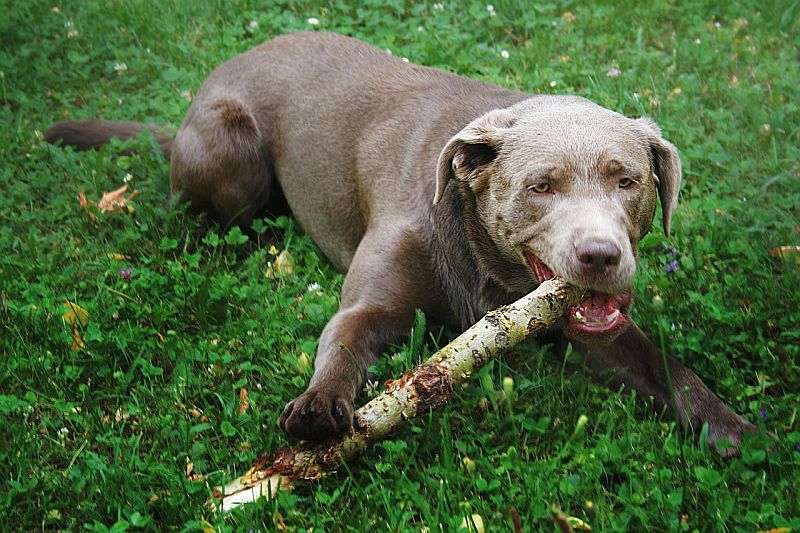
Does your doggo try to eat things during walks or while playing in the backyard? You’re not alone — many dogs try to nom-nom-nom on things they find outdoors.
A few of the most common items dogs eat while outside include:
Common Indoor Items Dogs Eat & Chew
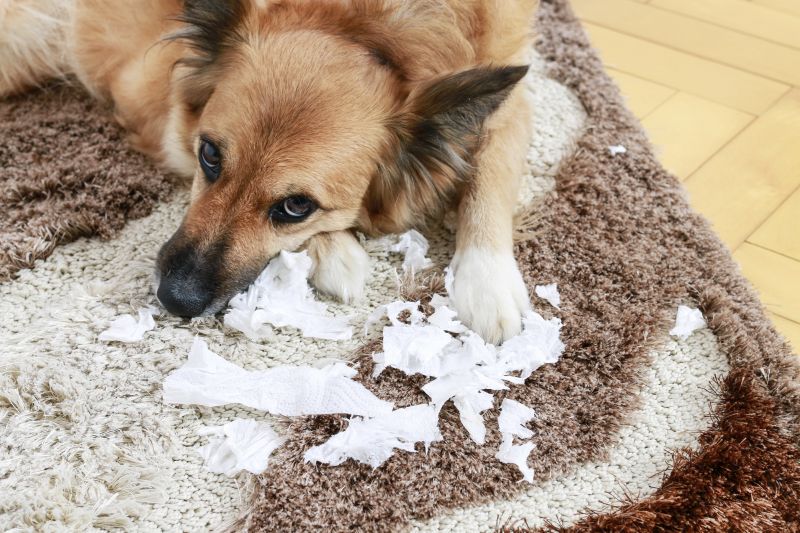
Problematic eating and chewing behaviors can also occur indoors. This can actually be more worrying, as you probably don’t watch your pooch as carefully when she’s indoors.
Some of the most common canine chomper targets found indoors include:
- Fabrics
- Socks
- Underwear
- Toilet Paper
- Batteries
- Pencils
- Crayons
- Chocolate
- Cigarettes
- Soap
- Ant traps
Of course, this list is not exhaustive – some dogs try to eat everything that they can fit in their mouths!
But, keep these commonly consumed items in mind and be ready to intervene if your dog grabs one. This is vital for keeping your dog healthy and safe.
Why Do Dogs Eat Things They Shouldn’t?
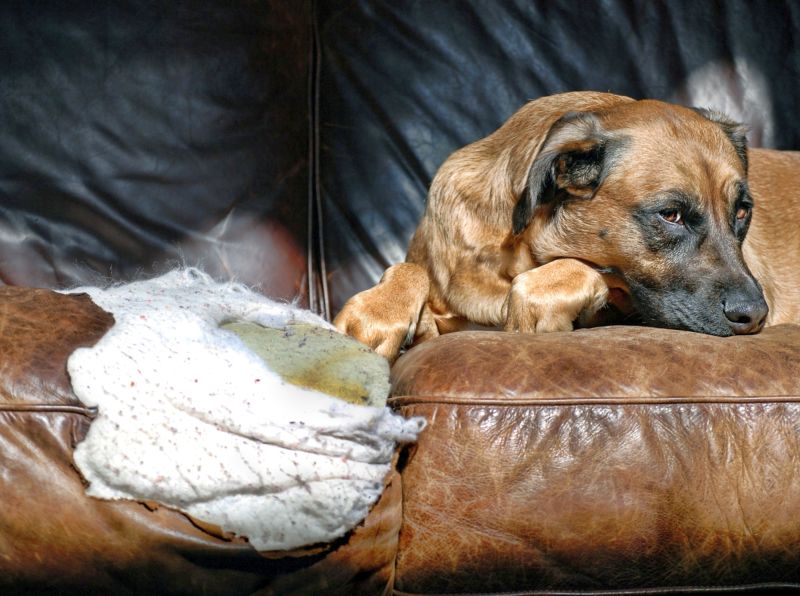
Now that you have an idea of what things dogs love to chow down on that aren’t normal foods, that begs the question – why would they want to eat these things anyway?
We’ll explain a couple of the most common reasons dogs nom things they shouldn’t below.
Pica: An Unusual Medical Problem
Nutritional deficiencies are sometimes the driving force behind eating weird stuff, and dogs with these kinds of medical issues may develop a condition called pica. This means your dog is eating non-food objects with little or no nutritional value.
If you are feeding a high-quality, commercially prepared dog food with an AAFCO statement on it, your dog should be receiving all of the balanced nutrition she needs.
However, if your dog has a medical issue that is keeping her from properly digesting her food, or from absorbing the nutrients, pica could be one of the symptoms. Communicating with your vet and taking your dog for an exam is a good first step.
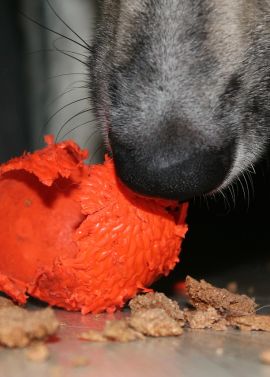
Retained Scavenging Instincts
Another reason dogs eat odd things is their scavenging background.
Our pet dogs evolved from wild canids who probably ate pretty much anything they could digest. And because dogs explore their world with their mouth, and the best way for them to figure out if they can digest something is to eat it and see what happens.
Hunger-Motivated Munching
A number of dogs will eat random stuff when they’re simply hungry, and some dogs seem to feel hungry a lot!
Dogs with medical conditions like a thyroid imbalance or a digestive issue often seem to feel extra-hungry. Some medications can also increase a dog’s appetite, and overweight dogs who are on a low-calorie diet may also feel quite hungry between meals.
Boredom: Eating When There’s Nothing to Do
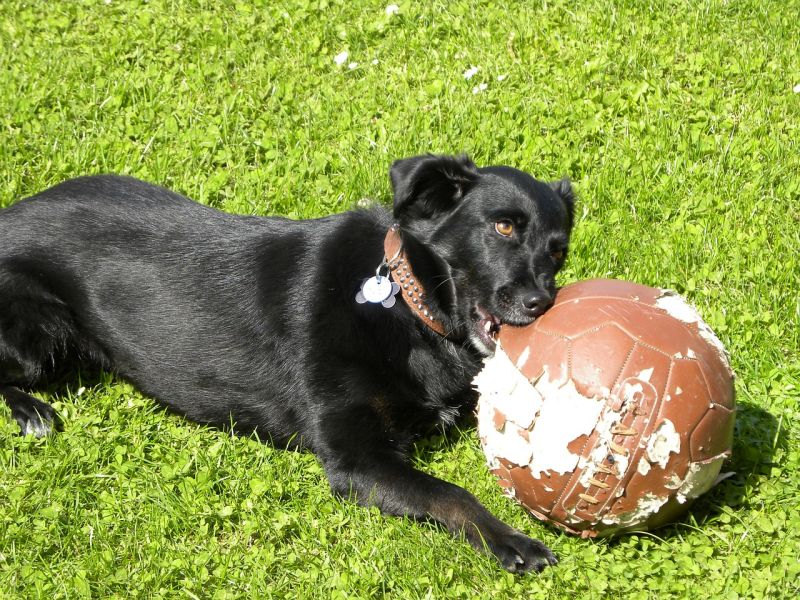
Bored dogs will try to pass the time in any number of ways, like eating things they shouldn’t. Chewing and eating random items will sometimes make it on an unoccupied dog’s mental list of ways to entertain herself.
Similarly, dogs who are anxious or frustrated may chew and eat objects as a way to calm and soothe themselves.
Soothing Teething Pain
Teething puppies are major gnawing and nomming culprits, For starters, chewing on things can help ease the pain caused by their erupting teeth.
But also, from a puppy’s point of view, the whole world is new, amazing, and possibly edible! How will they ever figure out which chewables are their favorites unless they give everything a try?
How Can You Stop Your Dog From Eating Everything?
When your dog has been eating things she shouldn’t, it’s best to make sure your dog doesn’t have a medical issue that needs attention. So, start by making an appointment with your vet if your dog has been eating odd things.
Your vet may check for nutritional imbalances to see if an internal issue is making your dog crave strange objects.
If your dog is eating everything because she is extremely anxious or stressed, your vet may also prescribe anxiety medication or calming supplements to help reduce the problematic eating behaviors. However, medication alone is rarely an effective solution since it doesn’t deal with the root cause of the dog’s stress.
Once your vet has verified that there aren’t any health concerns at play, you can start trying to fix the problem.
When dogs consume things they shouldn’t, there are two main solution types you can try while fixing the problem: management and training.
Most often, a combination of the two works most effectively, as this will prevent your dog from rehearsing the problematic eating behavior and teach her to replace it with a different response.
Management Solutions for Dogs Who Eat Everything
In a dog-care context, management means adjusting your dog’s world so she can’t keep repeating the behavior you don’t like.
When considering management solutions for your continually-consuming doggo, first observe the situation.
For instance, if your dog is only eating weird stuff when she’s out on walks, she may only need management. You can simply be doubly cautious on walks to avoid road noms.
Management solutions are usually best for preventing the problem behavior from happening at the moment, but you’ll almost always want to use management combined with training techniques so that you aren’t 100% reliant on management strategies.
Preventing Your Dog From Eating Things While Outside
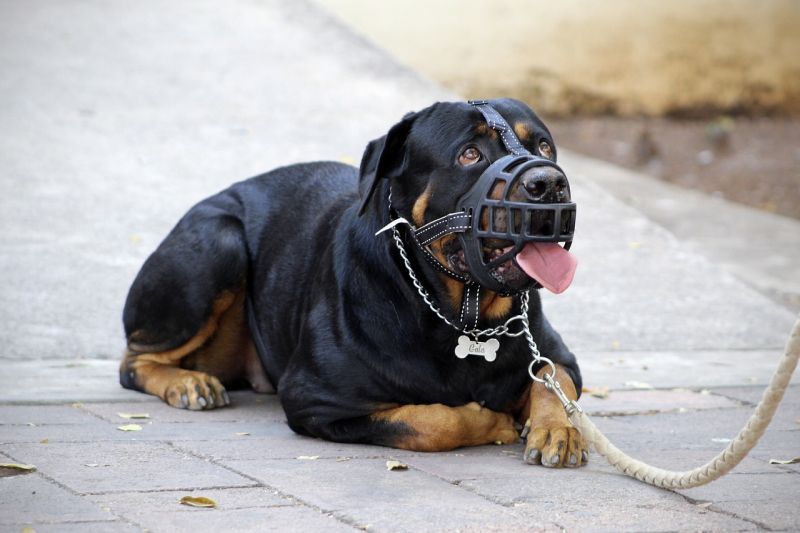
When out on walks, keeping your dog on a leash is the easiest way to supervise her and to manage her nomming naughtiness.
Loose, unsupervised dogs can get into all sorts of mischief, and if your dog eats something that requires veterinary attention, your inability to tell the vet what she got into makes it that much harder for your vet to give her the best care possible.
Also, sticking to places where your dog is less likely to encounter potentially dangerous snacks can help prevent the problem. So opt for cleaner parks and walking routes and avoid places that are perpetually littered with things that’ll interest your pooch.
Try Muzzle Training to Deter Your Dog from Snatching Road Snacks
Another piece of the management puzzle that works wonderfully for many dogs is the use of a basket muzzle. Just be sure you choose the muzzle carefully (you can also go the DIY route, if you like).
Nylon or occlusion muzzles keep dogs from being able to open their mouths at all, which makes panting or drinking impossible. This makes these types of muzzles unsafe to use during walks since dogs cannot cool themselves while wearing one.
Basket muzzles, however, still allow your dog to pant, drink, and eat treats. Just be sure to muzzle train your dog so that she gets used to wearing a muzzle before leaving it on her for any amount of time or going for a walk. This will help her wear it without feeling fear or stress.
Prevent Your Dog From Eating Things While Inside
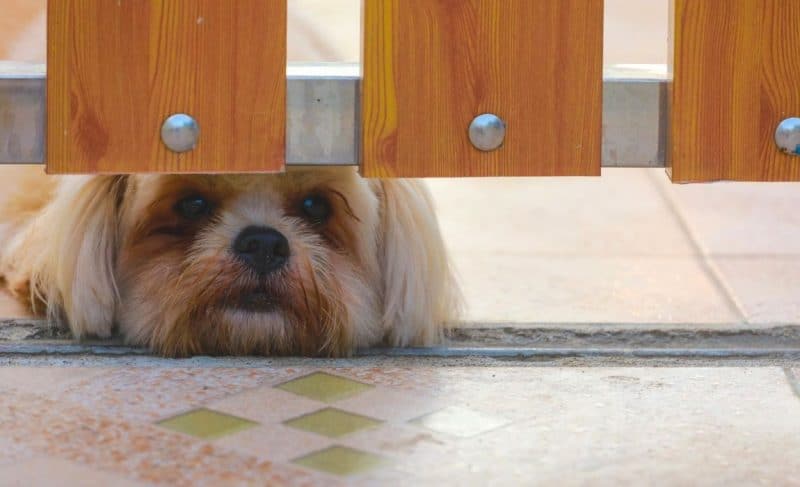
When you’re at home with a dog who has been demolishing and consuming odd things, there are a few management solutions that can help.
Avoid Leaving Food Out Where Your Dog Can Access It
The first step is to remove tempting items from your dog’s reach and keep them put away. This will help prevent your dog from jumping up on the counter and accessing things, which will help protect her (and your sanity).
Provide Better Chew Options
Then, provide enough proper toys for your dog to safely play with and chew on (it is a natural doggo behavior after all). Many dogs who chew and consume inappropriate objects simply want to chew more often, and directing those instincts to safe toys will give you the opportunity to reinforce your dog for choosing good items for chewing.
Many owners think they need to stop their dog from chewing, period. But chewing is a natural behavior for dogs that shouldn’t be shut down.
In fact, chewing can relax dogs and provide a calming effect.
Instead, work on redirecting your dog to appropriate dog chew toys so that your pooch can get the benefits of chewing while keeping your furniture free from teeth marks!
You can also try to manage the problem by keeping your canine’s cranium occupied. Offering more mental stimulation to your dog by providing treat-dispensing toys is an excellent way to keep her busy and focused.
There are also a few special things to keep in mind with young doggos. Because they are busy exploring the world with their mouths, puppies will always need a larger number of toys and chew items available than the average adult dog will.
Providing a large variety of toys (and regularly rotating the available toy selection) can make your pup’s toys seem more interesting and novel. This will help her choose to grab her toys when she’s feeling mouthy.
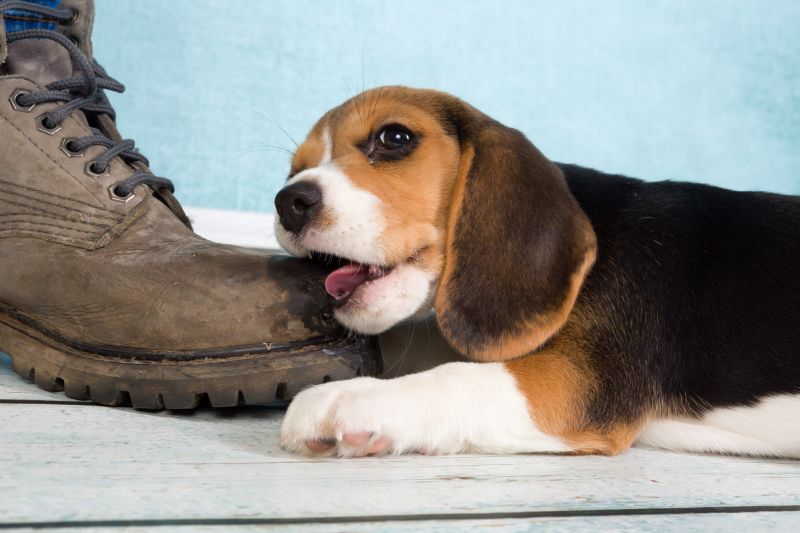
Bored, energetic dogs will always find ways to occupy themselves, and chewing and eating things is a common way that dogs deal with extra energy.
So, make it a point to exercise your destructive chewing doggo more thoroughly, or more often. This may make all the difference as you try to get your problem chewer to take it easy.
If your dog has been excavating snacks out of the trash can, finding an inaccessible place to keep it (like inside a pantry with a closed door) or acquiring a dog-proof trash can is often an excellent management technique.
Use Gates, Pens, and Crates to Keep Your Dog Supervised and Confined to a Safe Space
Extra supervision will also help. For example, you may want to limit her roaming space in the house by using indoor dog gates, baby gates, or dog playpens. This can help keep her nearby and easier to manage. It can also give you the opportunity to reward her when she chooses good, safe things to chew.
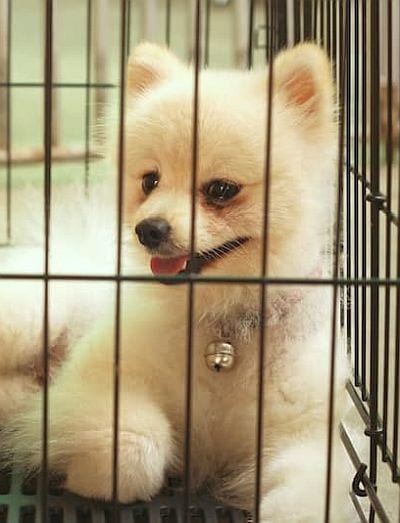
Another strategy, known as umbilical cord training, consists of attaching your dog’s leash to your body. Like playpens or baby gates, this will allow you to keep a good eye on your little four-footer and prevent her from eating things she shouldn’t.
Crating your dog is also a good short-term strategy if she can’t be well-supervised otherwise.
Just understand that this is not a good permanent solution. Your dog cannot spend her life constrained to her crate. So, at best, it’s a stop-gap fix you can use while working on training solutions.
But don’t just start locking your doggo in a crate right without any prep work. Make sure she likes spending time there first, by using positive reinforcement training methods to crate train her.
Keep in mind, good management only works as long as you are willing to consistently put forth the effort.
Since no behavior modification training is involved with this solution type, your dog will only be prevented from repeating the behavior you don’t like, and not learning how to do something different.
Training Solutions for Dogs Who Eat Everything
Training solutions involve teaching your dog new behaviors that are not compatible with her eating inappropriate items. This way, you can get her to do something else before she consumes whatever it is she’s so excited about ingesting.
A great way to change problematic eating behaviors is to teach your dog a new desired behavior, then replace the unwanted behavior with a new one.
The best replacement behaviors are incompatible with the problem behavior. Since eating things requires the use of your dog’s mouth, teaching her some cues relating to “mouth control” can be extremely useful if she’s been eating bad stuff.
We’ll discuss a few such cues below.
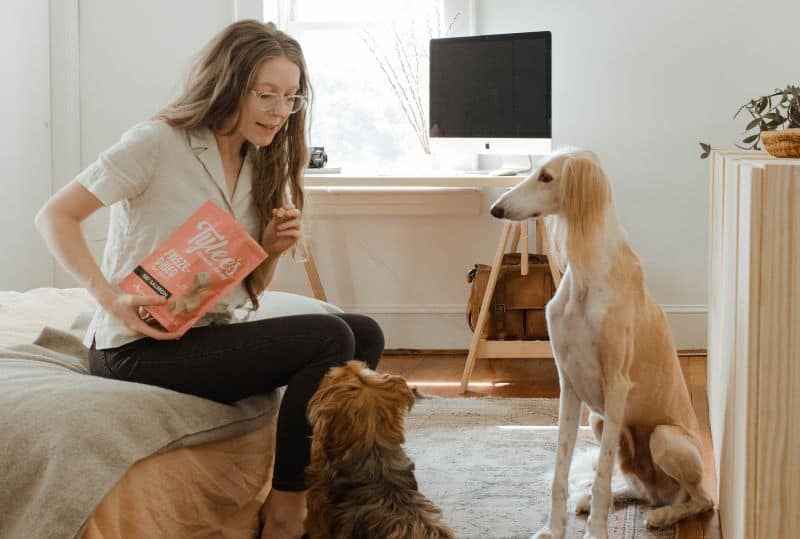
“Leave It”
My favorite behavior to teach dogs who put the wrong things in their mouth is “Leave It.” It basically lets your dog know that you want her to ignore whatever she’s focused on, before she picks it up, and to pay attention to you instead.
Practicing with a “Leave it” treat as well as some other treats of the same type can help your dog learn that you will let her know which treats are not for her. If she looks at you instead of trying to grab her “Leave it” treat, she’ll get the same type of treat from you with less effort.
Also, if you practice “Leave It” with lots of the same type of item, it can help your dog build pattern awareness, so your dog begins to automatically look at you when she finds something yummy.
For example, if your dog has been eating socks, and you practice “Leave It” successfully with a bunch of different socks, your dog will hopefully look at you rather than consuming a sock when she comes across one.
To teach your dog to “Leave it,” do the following:
- Step #1: Toss a yummy treat down on the ground but cover it with your hand. Your pooch will undoubtedly try to get to the treat, but don’t let him have it. Then, once he stops trying, say “Good boy” or click your clicker and give him a treat. But here’s the thing: Don’t give him the treat under your hand – give him another one from your treat pouch.
- Step #2: Practice this procedure several times. This will help him learn the lesson and internalize things.
- Step #3: Increase the difficulty level of the procedure. The best way to do this is by leaving the treat on the floor uncovered and out where your pupper can see it. But – and this is important – don’t let him get to the treat if he tries to snatch it. Just re-cover it with your hand or foot if need be. Once he looks at you, stops looking at the treat, or demonstrates that he “gets” the idea, click your clicker and give him another treat.
- Step #4: Make things even harder by practicing while your dog is attached to his leash and you’re standing up. Now, you’ll have to use your foot to block the treat if he tries to grab it. As you’ve done earlier, click and reward him when he demonstrates that he’s not going for the treat.
- Step #5: Incorporate the “Leave it” cue. Once your dog is automatically leaving the treat alone once dropped on the floor, you’re ready to associate a phrase (“Leave it”) with the cue. In other words, drop the treat and then say, “Leave it.” As long as your doggo ignores the food, you’ll click and reward him. Make sure to block the treat with your foot if he does try to grab it.
“It’s Your Choice”
The training practice called “It’s Your Choice” is another strategy that can help with a dog who devours items. “It’s Your Choice” can help teach your dog some default impulse control.
First, put some treats in your hand. Let your dog sniff, nibble, or paw at your hand, but don’t open your hand yet. When she stops interacting with your hand for a second, open your hand and give her one of the treats in it.
Gradually increase the amount of time between opening your hand and giving your dog a treat to improve her impulse control.
This skill can help improve a dog’s impulse control and increase a dog’s avoidance of desired items without a verbal cue. Practicing with treats, the dog learns that if she ignores the pile of treats, she will get one from her caretaker instead.
“Drop It”
Along similar lines, “Drop It” is a handy cue to use if your dog has already picked up something in her mouth.
The cue lets her know that if she lets go of what she’s holding, you will trade her for a treat.
Initially, practice training the “drop it” command using a lower-value item (like one of your dog’s toys) in exchange for a higher-value reward (like a piece of chicken).
Having your dog drop a toy in exchange for a treat is often the most effective method to start (although if your dog is crazy about toys, this might not be the case. Make sure you understand what your dog considers a low-value and high-value item).
Once she is dropping toys easily, you can practice having her drop higher value items.
Generalizing “Drop It” to include longer-lasting chewy treats like bully sticks can help your dog realize that she can take a break from chewing for a moment to eat your small, super-tasty treat. Then, she can go back to chewing when you return the bully stick to her.
Do the following to teach your dog to “Drop it”:
- Step #1: Start playing with your dog using a beloved toy (such as a tug rope). Have your pooch grip the rope with his mouth and play a short session of tug.
- Step #2: Wait for him to drop the toy. After playing for a few minutes, stop tugging on the rope and be boring. Your dog should naturally drop the toy after a minute or two.
- Step #3: Start associating a phrase (“Drop it”) with the desired action. As soon as the toy falls out of your pup’s mouth mouth, say: “Drop it.” Once she does, give him a high-value training treat.
- Step #4: Reset for another repetition by picking up the toy as your pooch takes the treat. But understand that you don’t want to “bribe” him to drop the item. Just don’t let him see the food reward until after he spits out toy and you should be good.
- Step #5: Practice the cue to drive the point home. Lather, rinse, and repeat several times to help your pupper internalize the lesson. Play a short game of tug, stop, wait for the drop, say “Drop it,” and then reward him.
“Take It”
Finally, teaching “Take It” is a great piece of the mouth control puzzle. This cue lets your dog know that she can put something in her mouth, or that you’d like her to take something you’re offering to her.
Working on “Take It” and “Drop It” during a single training session is quite useful since your dog will naturally hold onto a toy when you ask her to “Take It,” and will likely be able to let go of the toy for a “Drop It” in exchange for one of your treats.
You can go back and forth between the two!
Gradually add time between “Take It” and “Drop It” in order to teach your dog to hold on to something for a little while.
This is an extremely useful behavior for a dog who has been putting problematic things in her mouth – if you’ve already given her the “Take It” cue and she has her favorite toy in her mouth, she usually can’t grab another object too!
To teach your dog to “Take it,” do the following:
- Step #1: Hold a treat in your closed hand. Allow – even encourage – your dog to try to get the trick by pawing or nosing your fist.
- Step #2: Wait until your pooch stops trying to grab the tasty morsel. Once he does, click your clicker or say, “Good boy!” Next, open your hand and say, “Take it!” Let Fido grab the treat at this point.
- Step #3: Practice the procedure repeatedly to drill home the point of the exercise. Eventually, your pupper should start backing away from your hand or just ignoring you entirely. At this point, you’ll want to start incorporating a brief delay between him backing away and you opening your hand and giving him the treat (1 to 2 seconds should suffice at the outset).
- Step #4: Make things more challenging. Now, you’re going to place the treat in your hand without closing your fist. Close your fist if your dog tries to take it, but if he ignores the treat or backs up, say “Take it” and let him have it.
Building Leash Manners on Walks
If your dog has been eating inedible things mostly on walks, one way you can reduce that behavior is to make interacting with you on walks more fun, and more “profitable” for her!
Practicing cues that your dog can do while walking, such as loose leash manners, name recognition, and hand targeting, can give her something better to do than stare at the ground for food trash.
This can also help her practice changing the focus of her attention easily from the rest of the world back to you, especially if she is earning yummy treats for her efforts.
The more often she successfully pays attention to you and gets rewarded for it, the easier it will be for her to ignore the things she would previously pick up and eat.
Ultimately, if your dog is having serious issues with consuming problematic or dangerous objects and these training practices seem to be falling short, getting in touch with a local force-free trainer is an excellent way to get fresh eyes and intellect on the problem.
My Dog Is Eating Everything: FAQs
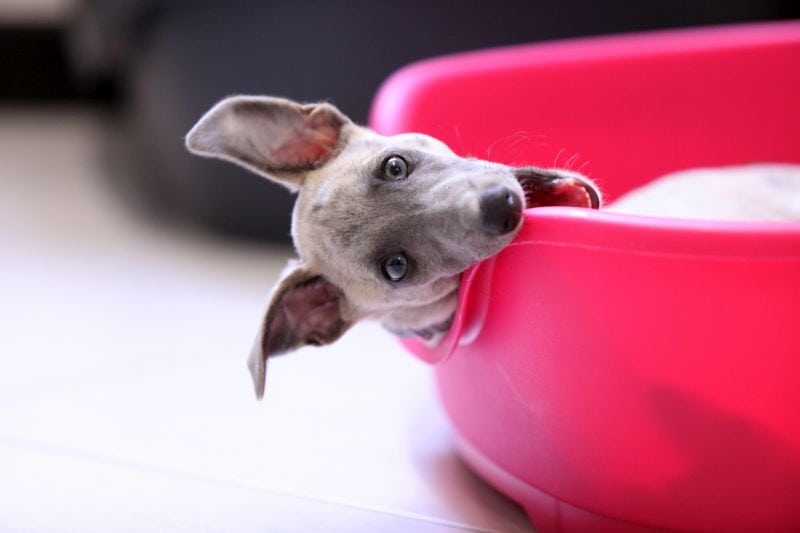
Many dog owners have similar questions about how to keep their dogs from eating everything, so we’ve answered some of the most common ones here.
Why does my dog eat everything?
There are many reasons a dog may want to eat all sorts of things, from boredom to medical problems. However, using a combination of good vet care, management, and training will help you put an end to the problem.
How do I get my dog to stop eating anything?
Since your dog is a unique individual, the best way to stop her from eating inedible items will be a combination of management and training specific to her. For example, teaching new cues like “Leave It” can be useful to help replace your dog’s troublesome eating habits.
Do dogs grow out of eating everything?
Many puppies chew somewhat less once they stop teething, but helping them learn what is appropriate to chew is an important part of raising a puppy. If a young dog is eating all sorts of objects, she will probably benefit from a combination of vet care, management, and training, and she may not simply stop as she ages if she is enjoying what she’s been doing already.
Why does my dog eat poop?
Many dogs who eat poop think the poop is a good snack. This could be because there are undigested nutrients in the poop that your dog wants to consume. As with the consumption of most undesirable items, a combination of training and management solutions will likely help.
How can you tell if a dog has pica?
Dogs exhibiting pica often eat odd, indigestible objects. They may then exhibit vomiting, diarrhea, lethargy, and lack of appetite. Contact your vet if your dog has been exhibiting these symptoms.
Dogs will always think that some really nasty things are just delicious! But, now that you know how to stop your dog’s crazy consumption of weird stuff, continued management and rewarding training should help keep your pooch safe and healthy.
***
Does your dog eat weird things? What is the strangest thing your dog has eaten? What solutions helped keep your dog from consuming stuff that was bad for her?
Share your experiences (and any questions you may have) in the comments below!
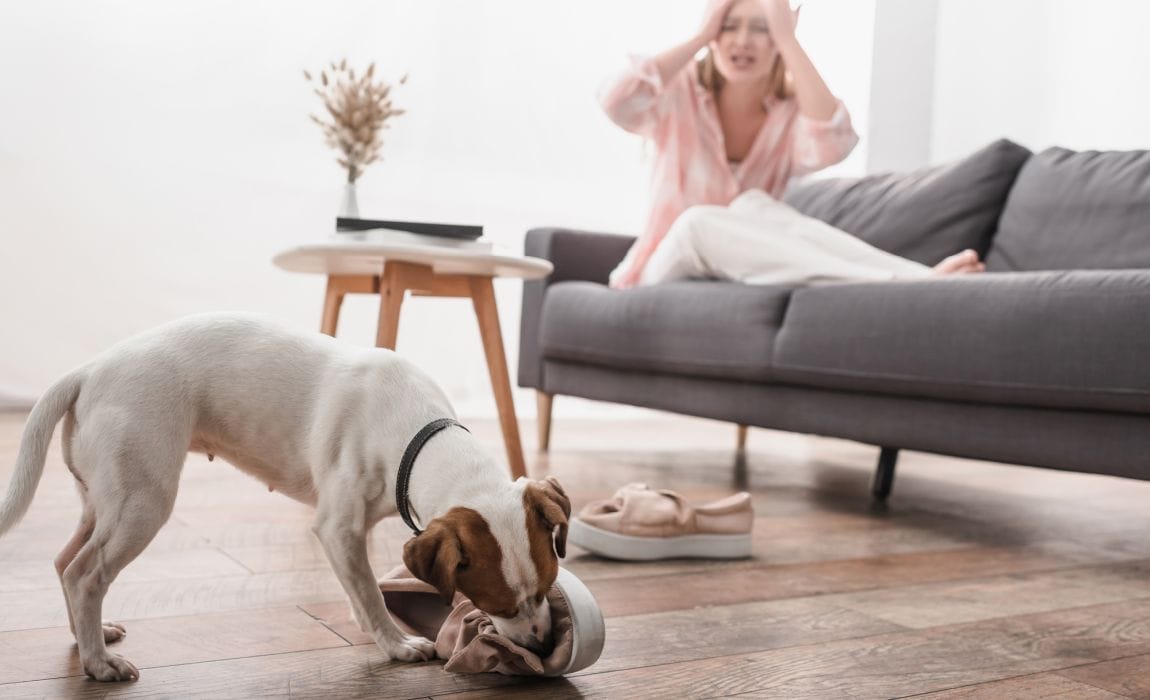

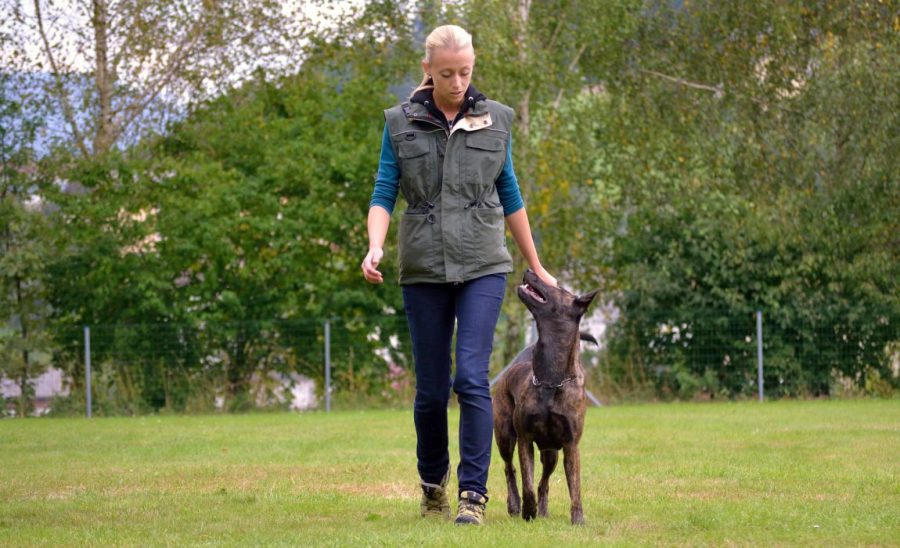


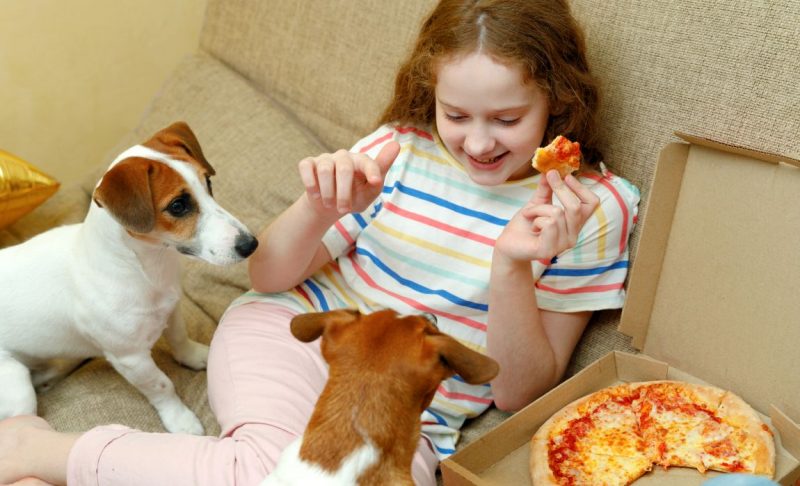
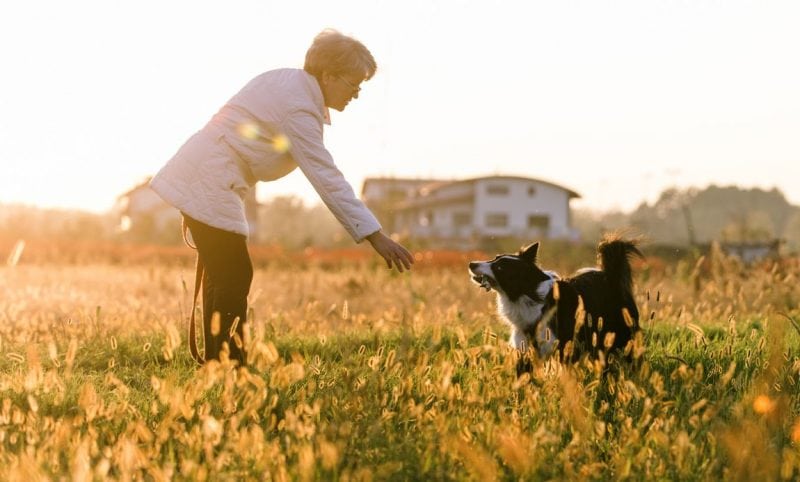
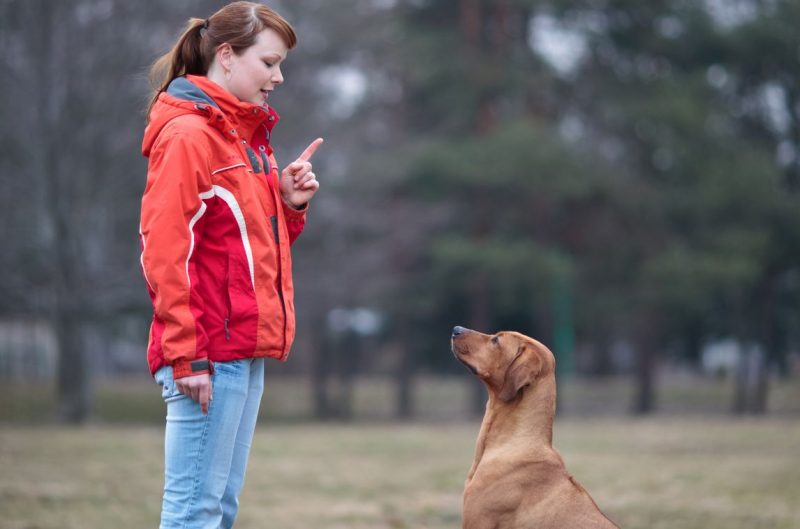
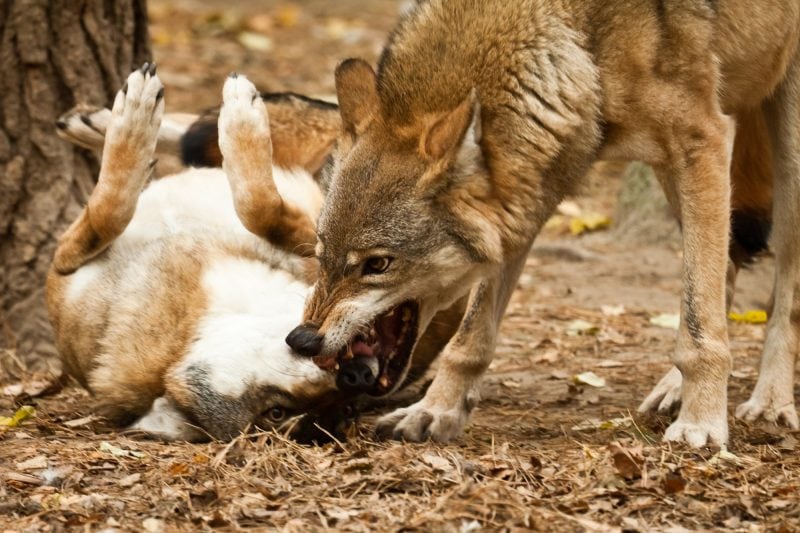
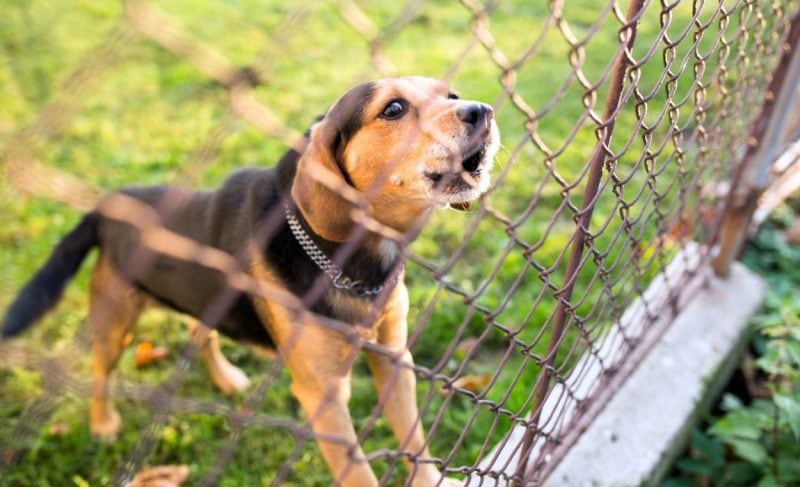

Leave a Comment